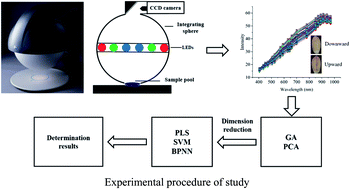Monitoring the growth of Fusarium graminearum in wheat kernels using multispectral imaging with chemometric methods
Abstract
Wheat is an important agricultural economic crop providing energy and nutrition for human beings. However, wheat kernels are easily contaminated with Fusarium graminearum that is harmful to human health. In this study, a rapid and nondestructive detection method has been developed to identify the degree of contamination and determine the count of Fusarium graminearum in wheat kernels using multispectral imaging technology. Based on genetic algorithm (GA) and principal component analysis (PCA) data preprocessing methods combined with partial least squares (PLS), support vector machine (SVM) and back propagation neural network (BPNN) chemometric methods, identification and quantitative determination models were established. The best result was obtained by GA-BPNN with an accuracy of up to 100% in the identification of the degree of contamination in wheat kernels at different contamination periods. Comparison of the results from different methods revealed that the best prediction of the count of Fusarium graminearum was obtained by GA-SVM with the correlation coefficient (R) in the calibration set and prediction set being 0.9663 and 0.9292, while the root mean square error (RMSE) in the calibration set and prediction set was 0.5992 and 0.6725 CFU g−1, respectively. It can be concluded that the combination of multispectral imaging and chemometric methods was potentially useful for rapid and nondestructive detection of cereal fungi in practice.



 Please wait while we load your content...
Please wait while we load your content...